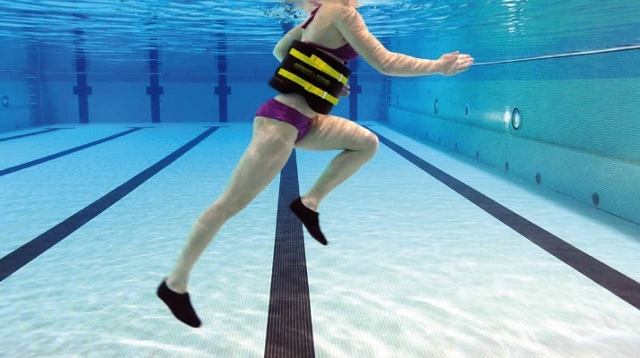As runners, we love to lace up our shoes and go explore a new trail and feel the wind in our hair. But what about cross training and running?

Truthfully, cross training and running have not always been great bedmates. After all, most runners would rather just run!
But hear me out – it can be really useful. What if cross-training – when used strategically – could help you run faster? Or recover faster in between hard workouts? Or maintain your fitness when you’re hurt?
Now I have your attention!
Cross-training is a powerful tool in your training toolbox and when used wisely, can dramatically improve your running.
I’ve used triathlon training to build a foundation that helped me run a personal record in the mile, a strong debut in 10k cross country, and race a 54:50 10-miler.
Pool running kept me in shape during a two-week injury (and then I ran a 9:04 PR in the 3k).
Cycling helped propel me onto the varsity cross country squad in college, resulting in a huge personal best over 8k.
But I’m not a special snowflake. My experience with cross-training is universal and can be applied to any runner, no matter your situation with running right now.
Injured? Yep, it can help.
Running strong right now? You should still cross-train.
Just learning how to start running? Cross-training is your new best friend.
I use different forms of cross-training at different times with the athletes I coach and those I write custom training plans for. It’s a smart way to jump-start your performance and accomplish more with your running.
What Types of Cross-Training Should I Do?
I’ll be blunt – I don’t like most forms of cross-training. I’m a purist and dislike most fitness classes at the gym, CrossFit, stair climbers, and other high-impact sports like basketball, soccer, ultimate frisbee, and softball.
If you want to be the Renaissance Man of general athletics, go have fun.
But if you want to run fast and stay healthy, let’s prioritize what’s important. There are two types of cross-training that are best for runners: strength exercises and endurance training. Here I want to focus on the aerobic aspect of cross-training – you can read more about strength here.
There are two ideal forms of exercise that fit into this category for two critical reasons. They’re pool running and cycling and they work so well for runners because:
- They’re as specific as you can get to running without actually running
- They’re impact free (no impact forces means the injury rate is dramatically lower, meaning less risk to you)
Because I’m a running coach and my job is to get athletes to the starting line in better shape with fewer running injuries, every aspect of training has advantages and disadvantages.
CrossFit is too nonsensical and risky.
Basketball is too ballistic and non-specific (but man, I love playing ball!).
Prancercising isn’t specific enough to running and too weird for normal people.
Cycling and pool running have a small injury risk, are specific to running, are widely available to most people, and can be used many ways to develop a more well-rounded runner.
So, how do you best use them to become a better runner?
Cross-Train for More Endurance

Healthy runners can strategically cross-train as supplemental exercise on top of their normal workload to boost their fitness level.
Earlier I mentioned that I used cycling to get in better shape for college cross country – the same year that I ran nearly a minute faster in the 8k and made the team’s competitive varsity squad.
How did I do it? I biked about four hours, split up over three sessions, on top of 80-85 miles of running per week.
Don’t be daunted by any of those figures. In fact, many people run a lot higher mileage. But the lesson here is to do more than you’ve done in the past.
Volume is important and if you can’t do it with running, cross-training can make up the difference.
I had run 80+ miles per week in the past. The difference this season was that the equivalent of 24 extra miles per week to my workload (my coach Jim Butler used a conversion of 10 minutes of cross-training equaled a mile of running from an aerobic perspective).
Here is a cheat sheet to help you add more cross-training to your running schedule:
- Before you start working out twice per day, increase the number of days you train to six. Many runners should take a day completely off every week.
- Reduce the intensity of your cycling or pool running sessions if you’re doing them the day after or before a long run or fast workout.
- Always prioritize your runs not your cross-training workouts.
- When in doubt, go slow. Even a super easy bike ride or pool run is helpful.
Most runners have the same weakness: a lack of aerobic fitness. Cross-training bridges the gap between not running enough and needing to run higher mileage.
I couldn’t run 100+ miles per week like some of my college teammates so I did the next best thing: I busted my ass on the bike.
Maintain Your Fitness
Cross-training workouts don’t just help healthy runners – if you’re injured, you can maintain your fitness (or even get in better shape) with good cross-training workouts.
Though, it’s easier to prevent injuries in the first place!
During my senior year in college I came off a great cross country season and was excited to run indoor track. But before my first race I strained a tendon on the top of my foot and flashes of a lackluster season scared me into action.
I got in the water and started pool running – sometimes twice per day. With advice from my coaches, I got healthy and after two full weeks of being in the pool, I ran my first race of the season and set a new personal best in the 3k.
Immediately, I was a pool running convert. “Those workouts really kept me in shape!” was all I kept thinking after I ran that PR. And in the next 6 weeks, I’d take another 16 seconds off that personal record.
The “secret” to successful cross-training when you’re injured is to mimic the workouts you’d normally do while running. As long as you can do it without pain, you won’t inflict any additional damage.
In the pool, I did tempo runs and intervals. I did 2+ hour sessions to simulate long runs. Instead of easy morning runs, I parked my butt in an Aquajogger for easy pool runs.
When you maintain both volume and intensity during a period of injury, you can maintain your fitness and often come back stronger than you were before you got hurt.
Now, if only I could find a way to make pool running less boring…
Boost Your Recovery
Contrary to popular belief, sitting on the couch for an afternoon isn’t the best recovery strategy. Indeed, active recovery beats passive recovery nine times out of ten.
Instead of taking a day off after a long run or tough workout, you may actually feel better and recover faster if you do some strategic cross-training. Easy pool running or cycling promotes healing blood flow and helps you move through a wider range of motion.
I did this during the summer before my senior cross country season. I already mentioned that I did about four hours of cycling every week. But I also pool ran for 30 minutes once per week after my Friday easy run.
Yes, you read that right: I did two workouts on my easy day.
Four factors made this recovery strategy work for me:
- Pool running isn’t a weight-bearing exercise so I wasn’t incurring any additional damage from impact forces
- Water is naturally therapeutic – the hydrostatic effect of water can help improve blood flow and recovery
- The duration of the workout was only 30 minutes – short enough to get my heart rate elevated but not long enough to induce fatigue
- The intensity of this session was absurdly low. I measured my heart rate occasionally to be around 120.
By following these same principles, you can include short cross-training workouts in your weekly schedule to help you recover from hard workouts or from a long run.
There are some good times to cross-train for recovery, like the day or afternoon after a difficult workout. You’ll get a recovery boost that will probably leave you more ready to tackle your next workout.
Plus the added aerobic exercise will help build your engine – double win!
Cross Training and Running – An Example Training Week
At SR, I like to give you as much actionable coaching advice that you can use today to help your running. So here’s how to implement this article in your running schedule.
Imagine you’re a healthy runner. How would you plan your cross-training workouts? If you run five days per week with a weekly long run and faster workout, here’s my suggestion:

In this example, Tuesday’s pool run is an easy recovery session. Both time and intensity is low to help you recover from the workout in the morning. The same is true for Sunday’s pool run – the goal of that workout is to help you recover from Saturday’s long run instead of simply taking the day off.
Wednesday’s cycling session can be longer and at a more moderate effort. Here the goal is to add volume to your weekly workload to increase your general endurance.
Scheduling your long runs, workouts, easy days, and cross training can be difficult around your job, family life, and other commitments. For the first eight years of my running career I had coaches who planned my training – without them I wouldn’t have progressed to where I am today. All I had to do was show up!
If you need help with a training plan to accomplish your next big personal best – or just point you in the right direction – our training programs include plans, cross training guidance, and strength routines to keep you healthy!
And the next time you hear a runner say, “What’s the point of cross-training?” you know where to send them!